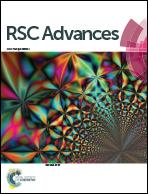Synthesis and characterization of Gd2Zr2O7 defect-fluorite oxide nanoparticles via a homogeneous precipitation-solvothermal method
Abstract
Defect-fluorite structured Gd2Zr2O7 nanoparticles were successfully synthesized via a homogeneous precipitation-solvothermal method using urea as a precipitant. The obtained nanoparticles were characterized by X-ray diffraction (XRD), Fourier transform infrared spectroscopy (FT-IR), scanning electron microscopy (SEM), Brunauer–Emmett–Teller (BET) analysis and transmission electron microscopy (TEM). Compared to the traditional solvothermal method, this homogeneous precipitation-solvothermal method has the advantage of producing nanoparticles with small grain sizes, a narrow size-distribution, high surface areas and little agglomeration. Particularly, the mean crystallite size of Gd2Zr2O7 obtained by this method is 20–30 nm, providing a great opportunity of using these nanoparticles as starting nano-sized building blocks for low temperature preparation of homogeneous and dense ceramics.



 Please wait while we load your content...
Please wait while we load your content...